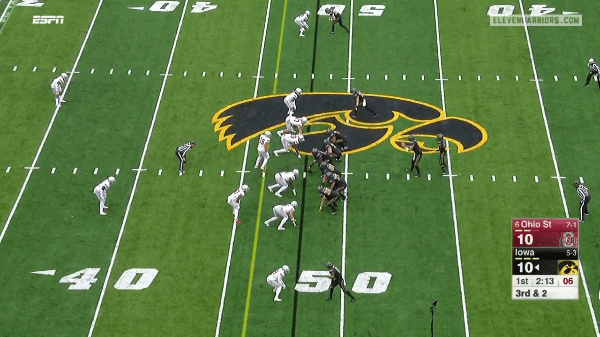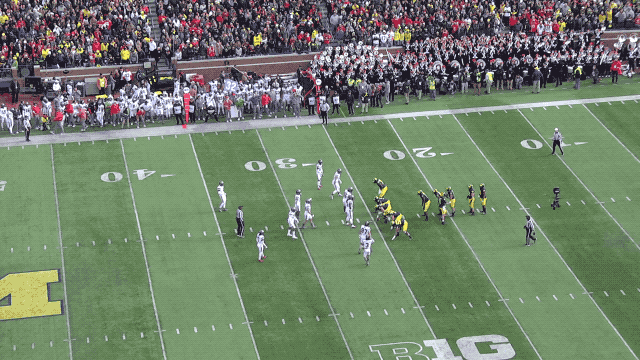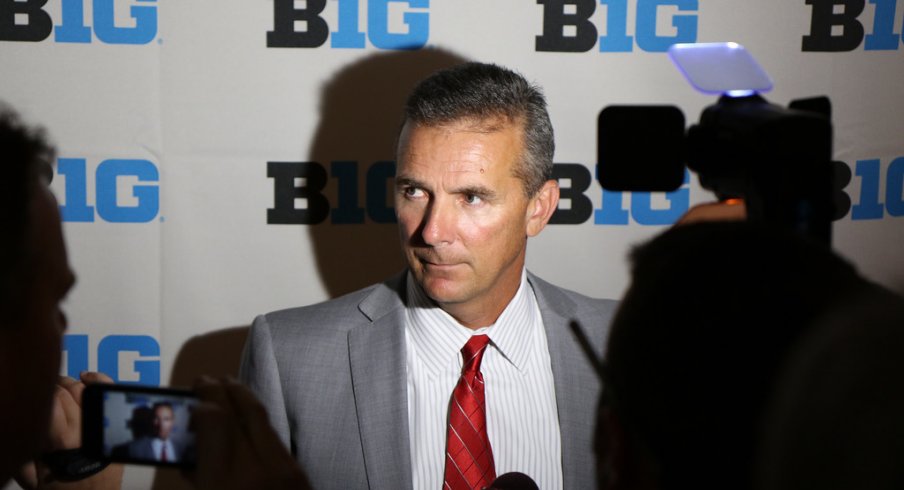With the commencement of fall camp still a few weeks off and my list of offseason topics fully exhausted, what better time than now to fall back upon the internet writer's favorite crutch? Just as we did in the inaugural Film Study Q&A, I harvested real questions from you all via the 11W forums.
I didn't answer every question asked, as some had been addressed in previous Film Studies (click the big red box above to find them all). But I tried to respond to the most common themes that could be found throughout.
Disagree with my #takes? As always, feel free to respond in the comments with your own thoughts. Now, onto the questions.
DeacBuck asked, "What is the most effective version of (an) RPO that the Buckeyes run? How many variations do they run? Who runs the most effective RPO in the country?"
This is a great question simply because it exposes some of the confusion around the subject of run/pass options.
In and of itself, an RPO is not a solution, but rather a means to an end. In the Ohio State offense, they're meant to open up the inside running game, as one or two defenders that might've otherwise spent the play sniffing out the run are now focused on defending a short passing route.
The most common way they do so is by adding a quick pass to the perimeter, often in the form or a bubble screen or a flat, arrow route to the tight end. Both routes pull the 'alley' defender in two opposite directions, giving the offense a numerical advantage to the direction opposite the one they choose.
However, these really aren't true RPOs, as they're simple pass routes attached to the same running play they'd have called anyway. If the defense recognizes the play and overplays both the run and bubble screen, the quarterback has nowhere to go with the ball, just as a defense that properly diagnoses any option play.
Coordinators Kevin Wilson and Ryan Day did include some more complicated RPOs on rare occasion last fall, however. These were multi-route passing concepts that allows the QB to read a pass-only defender as they would've with or without a running play attached.
But the reason OSU rarely called for such RPO concepts underscores why they're called at all. Since Urban Meyer took over, the Buckeyes have rarely run two-receiver concepts like the one seen above, given the amount of man and pattern-matching defenses they've seen. Rarely is one defender just sitting in a zone to can be read on such a route concept.
Instead, like all other coaches that have bought into the idea of RPOs, the Buckeyes use them to accentuate the core plays they already run well. Programs like Oklahoma, Clemson, and Ole Miss all heavily utilize RPOs in their offense, but do so with completely different philosophies in mind as they each have different methods for running and throwing the football. The only thing they have in common is that they give their QB the responsibility of reading a defender to make their decision to handoff, run, or throw.
Zimmy07 asked, "Do you ever see something that would make a good film study but hold back on it in case opponents may not have realized what you saw?"
No. If I can see it, the professionals that get paid hundreds of thousands of dollars already did so in only a fraction of the time.
Hovenaut asked, "What are your thoughts on the linebacker unit this year - steep learning curve with similar struggles (fullbacks/tight ends in the passing game) or do you anticipate improvement there?"
The performance of Ohio State's linebacking corps left quite a bit to be desired in 2017 but may have shown how spoiled the program had become by Luke Fickell's work with the group over the past decade. Under Fickell, Buckeye linebackers always seemed prepared to execute the game plan, despite whatever scheme may have been in place.
In both of OSU's losses last fall, Chris Worley, Jerome Baker, and co. were terrorized by opposing coordinators who seemed hellbent on making life miserable for them. Against Oklahoma, a bevy of perfectly called and executed play-action passes gave the aggressive group false signals, leaving numerous wide open spaces for streaking tight ends and backs releasing downfield.
Against Iowa, though, the unit simply seemed unprepared for west-coast passing concepts that, while not complex, require precision and communication to defend.

The good news, however, was that the same group showed improvement against these same concepts in the weeks that followed, largely shutting down similar offenses from Michigan State, Michigan, and Wisconsin. One major reason was the move of Chris Worley back to his more natural spot outside, leaving the more physical Tuf Borland to man the middle.
But another factor was simple familiarity. The Buckeyes built their defense to stop the spread-to-run attacks of teams like Oklahoma, Clemson, and Alabama a.k.a. their most likely opponents in a playoff game. Additionally, the majority of in-conference rivals run a similar scheme, meaning the OSU linebackers didn't see an opponent besides Rutgers line up in the I-formation until heading to Iowa City last fall, their ninth game of the season.
While being unfamiliar with simple two-back runs and subsequent play-action passes may seem strange to those of a certain age, the reality of today's spread-centric philosophies means it's quite possible that we may see the same mistakes again in the future.
Knarcisi asked, "At the end of 2014 we were running a lot of counters with a lot of success at the end of the season with Zeke. He scored in several, vs scUM, Wisconsin, and Oregon. They seemed to disappear in 2015 and since. Why is that?"
One of the more overlooked storylines of the magical 2014 season was the manner in which the Buckeyes ran the football during the final four games of the season. Most fans can tell you all about Ezekiel Elliott's 85-yard touchdown scamper in the Superdome, but the Wisconsin Badgers and Oregon Ducks surely have plenty of nightmares featuring Elliott and that dominant offensive line as well.
While Meyer's Ohio State offense had largely been based around zone runs up until that point, Elliott's elite athleticism and the technical superiority of a line that featured three eventual All-Americans gave Meyer and Tom Herman the confidence to implement a run game as diverse as any in the country.
But the issue with many of the gap-schemes they included, like counter-trey and buck sweep, was the lack of an option for the quarterback to pull the ball and run for himself, giving an all-important numerical advantage back to the defense. That disadvantage could be negated by the ever-present threat of a deep ball to Devin Smith off play-action, but once Smith departed for the NFL following the championship season, those run concepts became far less effective.
The concepts weren't retired entirely, though. As had been the case before Cardale Jones assumed the reins, the quarterback became the ball-carrier in the counter-trey scheme that pulls the backside guard or center and a tight end or running back to lead the runner through the C-gap.
Now, as the Buckeyes enter the 2018 season with two NFL-caliber running backs and a QB with less running prowess than J.T. Barrett or Braxton Miller, Wilson and Day have re-engineered the counter-trey scheme to fit their current personnel. As mentioned above, the addition of a bubble screen to the slot receiver puts the end in conflict, effectively removing him from the play and re-equating the number of defenders to be blocked back in the offense's favor.
How often this concept will be called will likely have to do with the weekly opponent and their desire to commit bodies to the bubble. But I'd be shocked if we don't see a fair amount of counter-trey in 2018.
Buckeye06 asked, "Why doesn't OSU run a 4-5 TE set with no WRs. They are the biggest mismatch position-wise in the NCAA and NFL, and OSU could get a bunch of good ones if they started emphasizing it."
[insert thinking face emoji]

Jamie Lannister asked, "Why are RB screens non-existent in our offense? And do you think we'll see more usage of our backs in the passing game this season?"
Long story short: screen passes are a pain in the backside to install and practice.
Unlike a bubble screen, which can be attached to virtually any run blocking scheme or quick pass protection, delayed screens to the back require a technique all their own. The line must make some contact with the pass-rusher across from them to give the appearance of a regular pass play before timing up their release downfield. Given that practice time is at a premium in an effort to prevent injuries, coaches must carefully edit their playbooks to feature only the concepts with the highest return on investment.
But given the aforementioned talent at running back, my guess is this question was asked out of a desire to see the ball in their hands as often as possible. Luckily, there are some solutions in place already.
HowSheGoneEat asked, "Who are your favorite teams/coordinators to watch from an X & O standpoint?"
As much as you might not like to hear it, the film of Oklahoma in the Horseshoe last fall might be my favorite game of 2017 to go back and watch, simply because of Lincoln Riley's brilliance. The way he married his GT-counter run with numerous passing concepts, both as RPOs and in play-action, was a thing of beauty. I honestly don't know what OSU could've done to beat them that night.
In addition to Riley, I love watching the film of some of the coaches I profiled in this space one week ago (Matt Canada of Maryland, Scott Frost of Nebraska, and Jeff Brohm of Purdue). Those guys all do a great job of using different formations and pre-snap motion to isolate individual matchups in their favor, which I truly believe is the most interesting way to play offensively today.
With defensive minds like Nick Saban and Brent Venables scheming up the perfect defense for everything you can draw on a whiteboard, the ability to put a player in a position to succeed in a one-on-one battle is the key to winning the modern game. With all the talk of NFL teams stealing college and high school ideas, the professional focus on personnel matchups is making its way to the college game, making the two products far more similar than people think.
Buckzilla1 asked, "SPIDER Y2 BANANA! Thoughts?"

Have any other questions that weren't answered? Ask away in the comments and I'll try to get to as many as I can.



